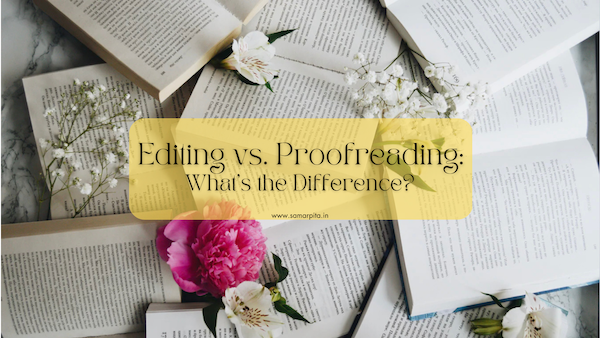Editing and proofreading are two essential steps in the writing process that can make or break the success of your written content. While they may seem similar, they are actually two distinct processes that serve different purposes. In this blog post, we will explore the key differences between editing and proofreading and why they are both crucial for producing high-quality written content.
Also Read: A Beginner’s Guide to Editing
Editing
Editing is the process of reviewing and revising written work to improve its content, structure, and overall quality. This stage of the writing process typically occurs after the author has completed a draft of their work. The goal of editing is to refine the piece, ensuring that it is clear, concise, and engaging. Editing involves a wide range of techniques, including:
- Reviewing content: An editor will review the piece for accuracy, completeness, and relevance, making sure that it aligns with the author’s intended purpose and message.
- Improving structure: An editor will look at the overall structure of the piece, making sure that it flows logically and that each section or chapter connects to the next.
- Enhancing style: An editor will look at the language used in the piece, refining word choice, sentence structure, and tone to improve its overall readability.
- Providing feedback: An editor will provide feedback to the author, offering suggestions for improvement and making sure that the author’s vision for the piece is realized.
Also Read: Breaking Down the Basics of Copyediting
Proofreading
Proofreading, on the other hand, is the process of reviewing written work to identify and correct errors in grammar, punctuation, spelling, and formatting. Proofreading typically occurs after the editing stage and is the final step before publication. The goal of proofreading is to catch any remaining errors and ensure that the written work is polished and professional. Proofreading techniques include:
- Reviewing for spelling errors: A proofreader will review the piece for any spelling errors, including common typos and misspellings.
- Checking for grammatical errors: A proofreader will review the piece for grammatical errors, such as subject-verb agreement and punctuation mistakes.
- Ensuring formatting consistency: A proofreader will ensure that formatting is consistent throughout the piece, including headings, font styles, and spacing.
- Reviewing for punctuation errors: A proofreader will review the piece for punctuation errors, including misplaced commas, missing periods, and incorrect use of apostrophes.
- Identifying inconsistencies: A proofreader will review the piece for any inconsistencies, such as changes in style or tone, and make sure they are corrected.
Also Read: Common Grammar Mistakes to Look Out For
The Importance of Editing and Proofreading Together
While editing and proofreading are two separate processes, they are often performed together to ensure that your written content is of the highest quality possible. For example, if you only proofread your content without editing it first, you may miss major structural or organizational issues that could impact the overall effectiveness of your writing. On the other hand, if you only focus on editing and fail to proofread your content, you may overlook minor errors that could detract from the professionalism of your writing.
So, which stage is more important? The truth is, both are equally important. Editing ensures that the piece is well-structured, engaging, and aligned with the author’s vision. Proofreading, on the other hand, ensures that the piece is free from errors and presents a professional image. Skipping either stage can result in a piece that is confusing, poorly written, and full of errors.
Also Read: Developmental Editing: Tips and Tricks
How to Edit and Proofread Effectively?
To edit and proofread effectively, it is important to approach each process with a clear plan and specific goals in mind. Here are some tips for effective editing and proofreading:
- Start with a thorough review of your content to identify any major issues that need to be addressed.
- Use a checklist or style guide to ensure that your content adheres to formatting and style guidelines.
- Focus on one aspect of editing or proofreading at a time (e.g. organization, spelling, grammar) to avoid becoming overwhelmed.
- Take breaks between editing and proofreading sessions to give your brain a rest and approach the content with fresh eyes.
- Consider enlisting the help of a professional editor or proofreader to provide an objective perspective and ensure that your content is polished and error-free.
In conclusion, editing and proofreading are both essential steps in the writing process that serve different purposes. While editing focuses on improving the content and overall quality of your writing, proofreading ensures that your content is error-free and polished. By approaching each process with a clear plan and specific goals in mind, you can ensure that your written content is of the highest quality possible.
This post is a part of #BlogchatterA2Z 2023
***
If you are looking for an excellent manuscript editor, someone to create content for your business, or an expert to help build your personal or professional brand on social media, then look no further and connect with me at editor@samarpita.in I can be followed on instagram at @samarpita and on twitter at @samarpitadotin.
***********
Read my ebook WRITE. EDIT. PROMOTE. to learn the basics about becoming an author – from writing your own book, to editing your first draft, and to promoting your book yourself! You can also read my ebook How To Write A Story Effectively and learn some valuable lessons about how a story can go from average to extraordinary. This book is part 1 of the series.
In fiction, I have two short stories for children in an ebook called Bedtime Stories.


